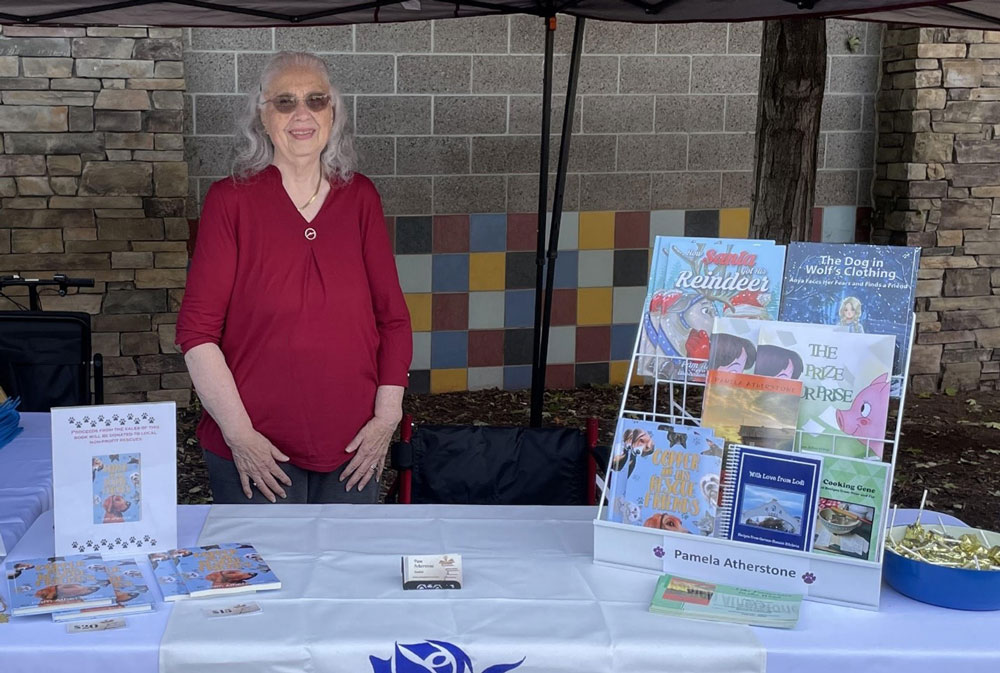Anne Marie Duquette interviewed Pam Atherstone, winner of the Books: Children and Young Readers (ages 9-12) category with her book, “Copper and His Rescue Friends.”
Congratulations on your win! Tell us about your experience and expertise and how this relates to your entry.
Rescue groups are a cause close to my heart, and I wanted to give back in a unique way to educate youngsters about them.
Except for my horse, who was born in my pasture, all of our animals are rescue animals and have been for more than forty years. Early in our marriage, my husband acquired an AKC rough collie, and we tried the show circuit for a few years, adding two females to our pack. But the expense of travel and other necessities, along with keeping regular employment, put an end to our aspirations. We moved to a place in the country, and over the years, those previous dogs were succeeded by dogs we rescued from various situations. We’ve had everything from Yorkies to Malamutes to mixes of all kinds.
We currently have two dogs. Suka, our Siberian Husky, was found roaming the streets of a bad neighborhood, scrounging through drug paraphernalia, looking for food. She was about six months old, emaciated, filthy, and with matted fur when she came to us. She is now six years old and a fantastic, loving pup. When she was about nine months old, Chloe, a Staffordshire terrier-Shar-pei mix, was dumped on the road on a scorching day (108 degree F). She was scared and had minor burns on her paws when my son found her and brought her home. She’s now two and quite a handful in her goofy way. She’s always into something, but we love her endlessly. We also maintain a colony of feral cats and have adopted an abandoned pot-bellied pig.
What target audience did you write for, and why?
My inspiration for “Copper” is the current situation in the pet world, specifically dogs, both purebred and mixed breeds. I feel that most problems with overfilled, overwhelmed shelters and rescue groups are a consequence of the pandemic and the current economy. Families staying home, especially those who worked remotely, obtained canine companions. However, those wonderful companions became an issue when people returned to work.
The current economy has also made having a pet expensive, and many owners can’t commit to feeding their pups before themselves, let alone pay vet costs. So the poor dogs have been surrendered to shelters or dumped somewhere, leaving caring people to help them. It’s an unfortunate situation, and by writing this story and targeting the middle school age group, I hope to educate and inspire them to step up and help in some way.
Why do you think it struck a special chord with the public and the judges—and with you?
The book is written from the dog's point of view. Having Copper tell the story just seemed natural. We all seem to anthropomorphize our animal companions in some way, so why not let them educate as well? I hoped doing so would draw young readers into the story and make it enjoyable.
The stories the animals tell are all based on actual events in some way, either through personal experience or from what rescue workers have related to me. The book talks about some harsh realities - a family member dying, abusing an animal, etc. It was sometimes hard to decide on the amount of detail to include. The harsh realities of life are just that—realities. I want kids to know that these things happen and they should know about them. Some of the tragic stories rescue groups have told me would make you sick. While I wanted to be honest about the realities, I didn’t want to overdo it. I want to educate without being sensationalistic. That is also why each chapter ends with a life lesson, whether it’s for Copper or the reader.
How big a part have dogs played in your personal and professional life?
Dogs have always been a large part of my life. As far back as I can remember, there was always a dog in my life, except for two of my college years when I lived in the dorms. I worked temporarily for an emergency veterinary clinic, where my eyes were opened to many things in the canine world (good and evil.) As for my professional life, I was (ironically) a letter carrier (mailman) for the postal service. My daily encounters with the dogs on my routes were 99% wonderful. Those few times when I did have an issue (I was bitten twice), I viewed it as a lesson in dog behavior so I could be more aware in future encounters.
What ongoing or future canine projects do you have planned?
I plan on writing more about Copper’s story sometime in the future. My books have all included dogs as part of the story, even though they may not be the main characters. I am currently working on my second historical fiction novel, and when that is completed, I can return to Copper.
Meanwhile, I will be content to have my two border collie girls curled up at my feet while I write.
What would you recommend to those peers who wish to enter your winning category in next year’s contest?
“Copper” is aimed at mid-grade readers, but that was challenging. Research on word count and current language is necessary, as is consideration for the different reading skills within an age group. I consulted several teachers and received helpful feedback, (although some of it was contradictory and confusing.) I can only suggest that keeping the story entertaining is the best way to approach your subject.
To conclude this interview, what thoughts from the heart would you like to share?
While I firmly believe in the adage “adopt, don’t shop,” I realize it isn’t for everyone. I also believe there are numerous other ways we can all reach out and assist rescues and shelters with the current situation of being beyond capacity: foster, volunteer, donate, and, above all, educate. Learn what rescues and shelters do to save unwanted or abused animals. Encourage friends and family to have their pets spayed and neutered. Share the importance of microchipping pets and keeping the microchip information up to date so lost animals are returned to their owners and don’t end up in shelters.
“Copper and His Rescue Friends” is my way of helping by educating children about rescue and donating the proceeds from the book's sales to local rescues to help the animals.
Anyone can do something to help save lives!
Congratulations again and thank you for sharing with us.


